The first article by M. D. P. [Mason D. Pratt] describes a field trip to an iron forge near Pine Grove, followed by a picnic at the grove with the students, teachers, visiting chiefs, the college band and some invited guests. “An Indian Boy's Camp Life,” by Henry C. Roman Nose, gives a short account of his activities growing up. An "Editorial"…
School News (1880-83)
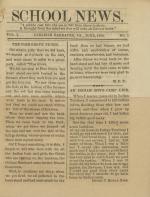
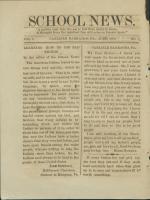
The first article is by John Downing (Cherokee), titles “Learning How to Use Bad Things.” In which he writes about alcohol and the benefits of being nice to the people of the United States, and a letter from Moses Nonway to his mother asking on the health of his people and reflecting on their poverty. The next page contained a list of small…

An excursion to Warm Spring opened this edition, titled “The Camp at the Warm Springs” by John Downing (Cherokee). They hiked all day until they reached the Springs, picking black berries along the way and at one point believing they had gotten lost. This proceeded an editorial on the benefits of sending Indian children to school, which was…
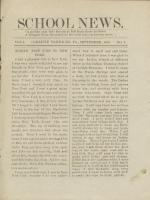
The opening piece was written by Roman Nose, titled “Roman Nose Goes to New York,” and it tell of his trip to New York City, visiting the Equitable Life Insurance Building and the aquarium, and the follows few weeks after his trip. He was one of the students who went on the Warm Springs trip mentioned in the previous issue. The following page…
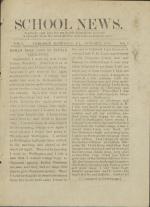
The fifth issue opens with Roman Nose describing his trip back to Indian Territory and his reunion with his family. While there he expresses his enjoyment of the school and the benefits of education, eventually convincing the chiefs to sends twenty-one Cheyenne children and Ten Arapahoe children with him to Carlisle. The article continues onto…
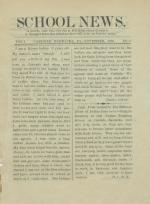
The first page has a short narrative from Joshua Given (Kiowa) on how he went from living in Indian Territory to studying at Carlisle and a brief paragraph from H.C. Roman Nose on how well and enthusiastically the students are learning. The editorial was about how smart Indians started to learn how to live like white men, and how thankful the…
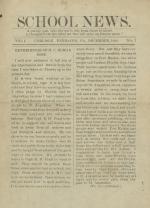
Issue Seven opens with Roman Nose explaining how he came to Carlisle after being held captive in St. Augustine for three years. He explains his time there was good because of the kindness of Capt. Pratt. After the editorial about the benefits of speaking English, there was a small letter from a Sioux boy named Phillip, to show how “large boys…
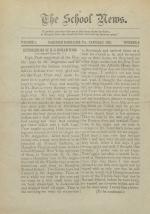
Issue Eight opens with a continuation of Henry C. Roman Nose’s journey from St. Augustine, to New York city and eventually Tarrytown, New York. The next page was an editorial on the importance of Hard Work, and how Indians should strive to work hard like White men do, along with a series of little blips about the school, including the arrival…
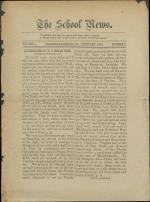
Issue nine, continues Roman Nose’s story, showing him attending Hampton School and eventually traveling to Lee, Ma. This issue’s editorial featured a piece on the hopes that the new U.S. President Garfield will put all Indian children in school. On the same page Robert W. Stewart (Creek) wrote about George Washington’s birthday. A bit about…
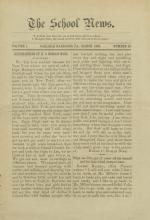
It opens with the conclusion to Roman Nose’s long journey to Carlisle. He explained how at Lee he learned to mow with a scythe and milk cows, before travelling to Carlisle Barracks, where he was happy to see other Indians following the “white man’s way”. Also on the first page is a small bit from Sophie Rachel (Nez Perces) on how she learned to…
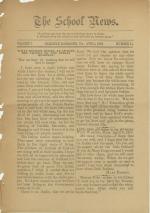
The opening article was written by Michael Burns (Apache), and focused on “The Indian Question.” In it he explains how many Indians falsely believe that white men are wiser simply because they are born white, and argues that their wisdom comes not from their skin color, but from more easily accessed education. The second page gives some…
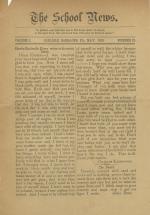
Number 12. Opened with a letter from Charles Kauboodle (Kiowa) to his cousin Laura, talking about what they’ve learned in school, their family, and wishing her a quick recovery from the sickness she has. Jessa Bent also had a few sentences on the desert published at the bottom of the page. The next page has a piece titled “Peace” about the hope…
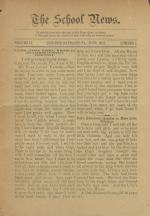
Page one opens with a letter from Lucius Aitson (Kiowa) to his father describing an illness he had that left him bed ridden for two weeks and how fond her is of English. Also on this page is a short bit from Nellie Robertson (Sioux) about the story of Moses. The next page had an article titled “A Little History of the Pawnee” by paper editor…
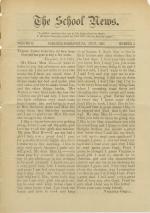
The entire first page is a letter from Virginia Oequa (Kiowa) to her teacher Miss H, sent after she left Carlisle to work on a farm for a few weeks. She sent her love and explained the pride she took in her work. Page two had two articles on the shooting of President James Garfield, written by Samuel Townsend (Pawnee) and Robert W. Stewart (…
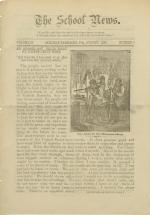
The August edition opens with an article on the need to be useful the Carlisle Children feel, and how badly the writer felt when unable to work while sick. It continued onto page four. Page two brings Samuel Townsend (Pawnee) stepping down as editor with Charles Kihega (Iowa) taking his place. There is also pieces on the possibility of moving…
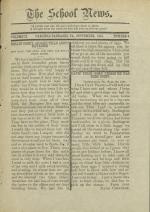
The first page is has a small narrative from Nellie Carey (Apache) on her visit to the Navajoes with her white family, She describes the Navajoes as dirty, explaining how they don’t keep their tents clean. There was also a letter from Davis Cheyenne (Cheyenne) to Captain Pratt about his time in Old Bucks. Charles Kihega (Iowa) and Ellis B.…
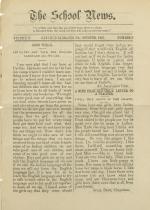
The first page has an article on Indian children learning to take care of themselves when their grown, like the white people do. It also had mentions of the benefits of forgetting Indian language. Julia Bent (Cheyenne) also wrote about the Chapel and her interactions Captain Pratt, and Miss Hyde. Page two had an article on the boys attending…
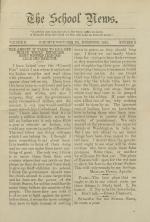
The first page talked about the cost of educating an Indian vs the cost of killing one to support the Indian Schools. The article was titled “The Amount it Takes to Kill One Indian Would Establish Many School Like Carlisle and Hampton” by Michael Burns (Apache). The second page has an article encouraging students to only speak English to learn…
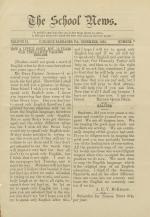
The first page opens with a letter from Ruben Quick Bear to his friend Austin, reassuring him that it is okay to make mistake when learning a new language. There was also an article describing the students as “Reapers of Knowledge.” On page two, Sarah, a Creek girl, wrote about the cooking school, and complaining about people not washing their…
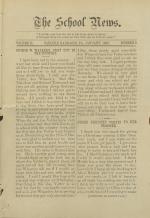
Page one described George W. Walker’s visit to the country, the people he met and how he would like to go to school with them. There was also thank note from Dessie Prescott to her teacher for a Christmas gift she received. Page opened with a letter from Edgar G. Squirrel talked of the shame the students feel when they speak Indian. Other bits…
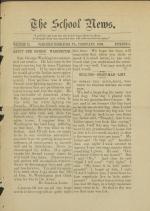
The first page had two articles on it. The first was by Johnson Lane about George Washington. The second was about various lost people and animals that the writer had met. Page two opens with Charles Kihega (Iowa) describing his tribe before and after coming under control of the agency. Another article talked about the Northern Arapahoe chief…
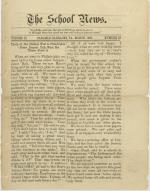
The first page opened with Dessie Prescott narrating the school trip to Philadelphia. While there, they saw toys, went to the Grand Depot, and sang for money for the school. Page two had an article about Tobacco, its side effects, and why it should not be used. Following was a letter exchange between Ellis Childers (Creek) and Mr. C. Kihega…
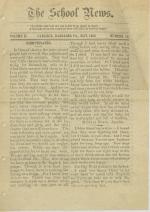
The first article is Titled “Communicated” by Michael Burns (Apache). It discusses the opportunities Indians have to access education. On the same page Libbie Standing (Cheyenne) wrote about Indians fighting and Joe Big Wolf wrote his father challenging him to speak English better than his son. On Page two Ralph Eagle Feather (Sioux) talked…
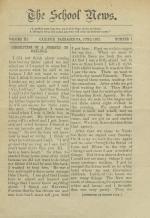
On the first page Justine A. LaFromboise describes her trip to Carlisle, explaining how her father convinced her to go get an education. The story continues on page four. On page two Ellis B. Childers (Creek) explained that he will be the editor while Charles Kihega (Iowa) visits home. C. Kihega examines the misconceptions whites and Indians…
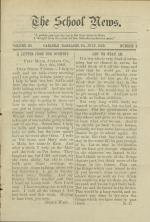
On page one Bessie West wrote her “School Father” about what she has been doing since she left Carlisle. On the same page E.C. compared Indian children’s want to go to school to a child who wants to swim, once they are allowed, they will take their fill before leaving. Following on the next page, Charles Kihega (Iowa) explained how little…
